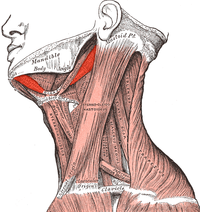Digastric muscle
| Digastric muscle |
|---|

|
| Neck muscles of man |
| origin |
| Venter posterior : Incisura mastoidea of the temporal bone - Venter anterior : Fossa digastrica of the lower jaw |
| approach |
| Intermediate tendon ( os hyoideum ) |
| function |
| Opener of the cleft mouth |
| Innervation |
|
Mylohyoid nerve (venter anterior) Ramus digastricus of the nervus facialis (venter posterior) |
The digastric muscle or muscle digastrius ( lat. : Zweibäuchiger muscle ), formerly known as muscle biventer mandibular called, is a muscle of the head, which results from two different plants, which is why he also two cranial nerves innervating is. It consists of two bellies :
- The venter anterior (anterior abdomen, in animals venter rostralis ) attaches to the inside of the lower jaw .
- The venter posterior (rear belly, in animals venter caudalis ) arises at the incisura mastoidea of the temporal bone (humans) or the processus paracondylaris in domestic animals .
In addition, the muscle is created in pairs, that is, it can be found on the right and left halves of the body. The two heads meet in the middle and form a common intermediate tendon (human, horse) or a tendon strip. The intermediate tendon is attached to the body of the hyoid bone with a connective tissue loop .
function
The digastric muscle is an opener of the mouth or muzzle and is thus an antagonist of the masticatory muscles .
Innervation
The anterior abdomen is innervated by the mylohyoid nerve of the mandibular nerve , the posterior by the digastric branch of the facial nerve.
Individual evidence
- ↑ Federative Committee on Anatomical Terminology (FCAT): Terminologia Anatomica . Thieme, Stuttgart 1998, ISBN 3-13-114361-4 .
- ^ H. Triepel: Nomina Anatomica. With the support of specialist philologists. JF Bergmann publishing house, Wiesbaden 1910.
literature
- Dieter Sasse: Compact textbook anatomy. Volume 2, Schattauer Verlag, 2004, ISBN 3-7945-2062-9 , p. 453.